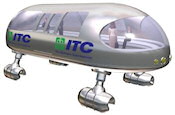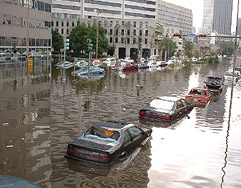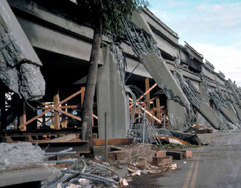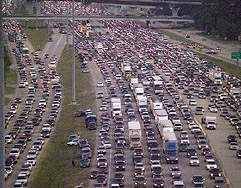This story first appeared in La Razón on September 11, 2009. To visit the Spanish-language original, please click here.

The rail, which will achieve 321 KPH, is designed such that only light propels it. Moreover, its hydrogen batteries and its conduction system will generate and distribute water throughout its entire length.
All great cities of the world face the same enemy: pollution caused by daily transport of the citizens who live there. Traffic jams and CO2 are an essential part of their routine. In Spain, according to a comprehensive report from the Railway Foundation, 24% of greenhouse gas emissions are caused by them.
Responding to this problem will not be an easy task. Nevertheless, Justin Eric Sutton, founder of the Interstate Traveler Company in the United States, has created a model of a high-speed train which will keep away from the atmosphere completely the harmful emissions since it needs neither fuel nor conventional energy in order to run. The Interstate Traveler will transport travelers from Detroit and Lansing (in southeast Michigan) by MagLev at 321 KPH with sunlight and hydrogen as its only sources of energy.
Over and above traveling at high speed, passengers won’t have to part with their car during their journey because the design of this new train includes special compartments for vehicles and freight.
 The attribute which sets it apart from the rest and makes it self sufficient, such that it can become a global prototype for transport, is the 5-meter-high metallic support structure upon which the magnetic guide way of the train is situated. On that support will be hung two rows of solar panels (5 square meters each) which, along the entire length of the railway, will produce 5.6 megawatts of electricity per hour of daylight.
The attribute which sets it apart from the rest and makes it self sufficient, such that it can become a global prototype for transport, is the 5-meter-high metallic support structure upon which the magnetic guide way of the train is situated. On that support will be hung two rows of solar panels (5 square meters each) which, along the entire length of the railway, will produce 5.6 megawatts of electricity per hour of daylight.
With that energy the hydrogen batteries will be charged, as will each vehicle. When they need recharging, hydrogen combustion will be used to produce the electricity which will power the train down the magnetic guide way, levitated as if it were a feather, without utilizing a drop of fuel.
As if that weren’t enough, the design of Justin Eric Sutton, does not try merely to save energy but, as the company has confirmed, can generate energy. Corbett Kroehler, Chief Media Officer of the Interstate Traveler Company, affirms that “The hydrogen which is not utilized to provide electricity for the train and Traveler stations will be stored in large tanks adjacent to the railway and directed to the US electrical grid.”
The company has calculated the combustion of the leftover hydrogen can yield 45 megawatts. The stations also have been designed to protect the environment. The Interstate Traveler Company that commits that there will be at least one station per city served by the train and they all will be self sufficient. That is, the hydrogen produced in the structures will generate sufficient water to supply to them and the solar panels on the rails, just like those installed on the roofs, will provide the needed electricity.
Additionally, inside the giant metal tube conduits will be installed which will serve to transport water, gasoline, hydrogen, electricity y fiber optic cabling from point to point along the railway. One advantage which these tubes will bring is transportation of fuel to gas stations will cease to be a source of pollution, given that, in areas near the railway, gasoline will be transported in the conduits.

WATER AND FOOD FOR ALL
In designing his train, Justin Eric Sutton didn’t have in mind simply not polluting, but rather that it be a source of resources to supply nearby areas y those places which need them the most. So, water produced from transforming hydrogen into electricity is not discarded. It is captured and moved along the railway supplying the areas along the rail and the stations which appear along the entire route. Moreover, the company will reserve surplus water to urgent drought areas or areas which have faced natural disaster.
Another manner of obtaining water is the depuration of sewage. As Corbett Kroehler has confirmed, for it, “We will use an innovative and environmentally friendly technique based upon an ‘electric plasma arc’ which, by electrifying the sewage, will gasify the remains in such a way that all which is left over is pure water.” This process, over and above not polluting, requires no use of special real estate such as a conventional water treatment plant. The company calculates that they can create thousands of liters of water within every 160 KM per hour of train operation.
Along the same line, they also intend to answer one of the problems which affects many areas of the plant, food supplies. The company intends to equip various areas along the rail with hanging gardens which will be irrigated by the water which continuously flows through the conduits of the Interstate Traveler. Moreover, these plantings won’t simply provide the benefit of growing food, but also will be capable of absorbing CO2. Corbett Kroehler has confirmed that, according to company calculations, “We calculated that each KM of gardens can remove 25 tons of CO2 per year.”
At the moment, the Interstate Traveler is only a study project. Representatives of the State of Michigan, Bill Rogers and Wayne Schmidt, announced this past March the creation of a working group comprised of various scientists who will study the viability of the project. However, the company is demonstrably optimistic and thinks that the train will begin running in the United States in 2010.
The downside of the project is the cost, since construction will cost 2.3 billion dollars. Hence, Juan Manuel Jiménez Aguilar, director of studies and programs at the Spanish Railway Foundation, opines that “It would be better in the short and medium term to dedicate those resources to investigation of applying solar energy and hydrogen to conventional trains, especially given the current global economic situation.” Even so, the company does not consider that the total cost of construction must be a problem, given that, since it will burn no fuel, the investment can be recouped in just three years.
Another blemish of the Interstate Traveler is that it is not as efficient as other high-speed trains. In fact, the speed of conventional high-speed trains is 50 percent higher than the Interstate Traveler. The energy consumption of the system is very great. In fact, as the Railway Foundation of Spain confirms, this form of transport is responsible for 40 percent of our national consumption of energy. For this reason, Mr. Sutton’s project has not been developed exclusively for the United States, but rather so that it can be established anywhere in the world.
JOURNEY TO LAKE CHAD
The Interstate Traveler Company has considered exporting its project to an area of the world with a large problem with water shortages, Chad. This great lake, which in 1963 had a surface area of 25,000KM², now reaches just 1,350KM². This loss has killed off agriculture and fishing. The company intends to bring its project to the east African coast, where it will begin building its railway and the conduits of its large metal supports which will bring sea water to Chad. Once there, the water will be subjected to a desalination process based on thermal evaporation. The solar panels along the rail will heat and evaporate the water. The steam will be captured and cast over the side as rain, as if from a local storm.
The company’s objective is to restore the lake and restart agriculture through new crops.
Tags: Hydrogen, Hydrogen MagLev, HyRail, Interstate Traveler, MagLev, Solar, Solar MagLev







 RSS Feed
RSS Feed
this post is very usefull thx!